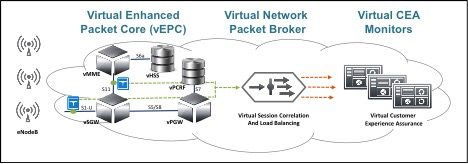Ixia looks at options for user experience monitoring in NFV deployments
Ensuring a quality subscriber experience is a critical requirement in traditional and mobile carrier networks. Monitoring subscriber experience in these traditional carrier and mobile networks is well understood. It involves tapping into the necessary network links with a network tap or using a mirroring port on the network switches. The mirrored traffic is then groomed and/or correlated by a network packet broker before being fed to an appropriate set of customer experience assurance tools or probes. The CEA tools are a key element in the carrier operations support system/business support system infrastructure.
However, mobile carriers now need to improve their overall business agility, flexibility and costs through the use of a virtualized network infrastructure or more specifically network functions virtualization. How is this visibility architecture affected by the implementation of NFV in these carrier networks? Until now the uncertainty of how to effectively deploy CEA tools has been a major hurdle for carriers considering NFV deployments. That is no longer the case.
Visibility in NFV environments
While NFV deployments do not fundamentally change a monitoring strategy, they do change the implementation options. For carriers considering NFV deployments there are three options for implementation of a visibility architecture:
Do nothing
Ignore customer experience and hope for the best. Of course this isn’t really a viable option.
A hybrid CEA monitoring architecture
Use existing physical CEA tools for monitoring a virtualized network infrastructure.
A fully virtualized CEA monitoring architecture
Use all virtualized components for monitoring the virtualized network.
We will examine the second and third options in more detail for CEA monitoring in a mobile carrier network using a NFV design.
Hybrid OpenStack visibility architecture for CEA monitoring
OpenStack is a common framework or platform under consideration for use in many of today’s NFV-based mobile carrier network deployments. Unfortunately, OpenStack does not have a mechanism to intelligently support the core requirement of delivering groomed and user experience correlated mirrored traffic to CEA tools. In fact, OpenStack does not have an intelligent mechanism to deliver mirrored traffic to any out-of-band tools. This includes monitoring, recording and security tools, all of which must be present to conform to service level agreements and regulatory compliance requirements.
A hybrid approach to CEA monitoring with OpenStack involves the use of:
• Virtual network taps.
• Physical or virtual network packet brokers.
• Physical CEA monitoring tools.
An NFV mobile carrier network built with OpenStack requires virtualized network taps to mirror traffic for monitoring purposes from both the UE control-plane and data-plane on S11/S1-u/Gn interfaces of the virtual evolved packet core. The v-tap forwards mirrored traffic to a virtualized or physical network packet broker. The network packet broker can in turn correlate and filter the voice-over-LTE and Web traffic from each UE and pass this data to the previously deployed physical CEA tools.
The obvious advantages of this approach is the opportunity to use existing NPB and CEA monitoring tools. In fact, this approach can serve carriers well as a first step to a fully virtualized CEA visibility architecture if there is the necessary capacity on the existing NPB and CEA monitoring tools. If not, a fully virtualized approach is most likely a better solution.
Fully virtualized OpenStack visibility architecture for CEA monitoring
An agile and flexible approach to CEA monitoring in a NFV-based mobile carrier network is to virtualize the entire visibility architecture. This means using virtualized versions of the network taps, as well as virtualized NPB and virtualized CEA monitoring tools all running within the same virtualized environment as the virtual network functions. The diagram below demonstrates how this environment looks, identifies the relevant monitoring components, and traces the monitoring traffic through the system.
OpenStack visibility architecture for CEA monitoring:

The advantage to this approach is that the mobile carrier can take advantage of a fully virtualized network, which includes automated provisioning, network changes, network upgrades and even network decommissioning.
Editor’s Note: In an attempt to broaden our interaction with our readers we have created this Reader Forum for those with something meaningful to say to the wireless industry. We want to keep this as open as possible, but we maintain some editorial control to keep it free of commercials or attacks. Please send along submissions for this section to our editors at: dmeyer@rcrwireless.com.

